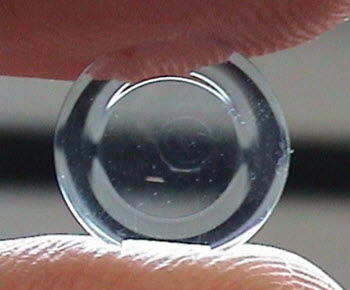The rigid contact lens was invented long before the soft contact lens. The earliest versions of rigid contact lenses were not intended for everyday use – they could more accurately be described as optical curiosities and scientific experiments.
Today, soft contact lenses are much more common than rigid ones, but there are situations where a rigid contact lens is actually preferable. In the year 2014, 6% of all contact lens fittings in the United States were for rigid contact lenses and 1% were for hybrid soft-rigid contact lenses.
 One example of a situation where a rigid contact lens is required is when we want the natural shape of the cornea to be replaced with a new refracting surface. This will correct for astigmatism. (Although, it is not the only alternative available. There are soft lens that will correct for astigmatism.)
One example of a situation where a rigid contact lens is required is when we want the natural shape of the cornea to be replaced with a new refracting surface. This will correct for astigmatism. (Although, it is not the only alternative available. There are soft lens that will correct for astigmatism.)
Corneal irregularities such as keratoconus can also be corrected with a rigid contact lens. A soft contact lens wouldn’t be able to do this job, specifically because it is soft and will accommodate to its surroundings instead of forcing its surroundings to accommodate.
It is also worth noting that rigid contact lenses are more chemically inert than soft ones. Because of this, they are preferred in certain challenging environments where chemical inertia is important.
Even modern rigid contact lenses tend to cause a bit of discomfort in the eye before the eye adapts to them.
History of the rigid contact lens
As mentioned above, the earliest rigid contact lenses were never really intended for frequent wear. A major milestone for the rigid optical lens was the invetion of the polymethyl methacrylate (PMMA or Perspex/Plexiglas) lense. This lens was practical enough to be considered a valid alternative to eyeglasses. Regrettably, it would not allow any oxygen to pass through from the air to the cornea.
In the late 1970s, materials were invented that made it possible to create rigid contact lenses that would allow at least some oxygen to pass through from the air to the cornea. One of the pioneers in this field was industrial chemist Norman Gaylord. These new rigid lenses became known as rigid gas permeable (RGP) lenses.
Hybrid soft-rigid contact lenses
A hybrid contact lens will be made out of both soft and rigid materials, and can provide a correction for which a rigid lens is required while at the same time offer some of the positive aspects of soft contact lenses when it comes to comfort.
A hybrid contact lens can for instance have a rigid center surrounded by soft material. For some configurations, a rigid lens is attached to the surface or a larger soft lens.
Hybrid contact lenses are unusual and few manufactures make them. As mentioned above, only 1% of all contact lens fittings in the U.S. in the year 2014 was for hybrids.
This article was last updated on: April 24, 2016

